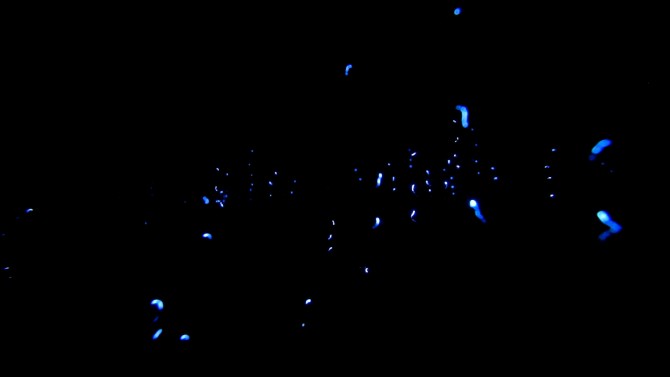In sea fireflies’ underwater ballet, the males sway together in perfect, illuminated synchronization, basking in the glow of their secreted iridescent mucus.
“It’s extreme,” said Nicholai M. Hensley, a postdoctoral fellow in the Department of Neurobiology and Behavior in the College of Arts and Sciences. “It’s an illustration of convergent evolution and a striking example of synchronized bioluminescent mating displays. The males are putting it all out on the dance floor. It’s a big bright display.”
Thousands of male ostracods dance underwater along the sea floor in synchrony to attract the attention of females.
Hensley is the lead author of new research unwrapping the vivid mating ritual of minute crustaceans called ostracods, which was published Nov. 29 in the Proceedings of the Royal Society B.
Ostracods are tiny crustaceans – the size of sesame seeds – found just offshore in the sandy seagrass and reef areas of marine waters. Males of the shrimplike species, called “entraining grassbed downer” or EGD for short, create distinct patterns of bioluminescence to attract females by secreting packets of protein from a specialized gland. In response, the females angle themselves to the bright blue luminous displays and swim toward the males.
“It starts with one male secreting a little ball of glowing mucus,” Hensley said. “Then repeats this several times while swimming and it creates a kind of Morse code pattern of light in the water. Then other males start their synchronous luminous displays and soon underwater – when it is dark – it looks like stars blinking with tiny trails of light.”
The synchronized swim doesn’t happen randomly, the scientists noticed. In fact, the mating dance sequence only happens after sunset at nautical twilight when the moon isn’t bright in the night sky.
The ostracod species EGD was first discovered in 2017 by James Morin, professor emeritus of ecology and evolutionary biology (A&S) and Todd Oakley, professor at the University of California, Santa Barbara, while they explored near the Smithsonian Tropical Research Institute’s Bocas del Toro island research station in Panama.
A male ostracod, about the size of a sesame seed, will dance in harmony with other males underwater at night and secrete a glowing mucus to get attention from females.
Morin, who has studied the mechanisms of bioluminescence in marine organisms since 1980, said there are more than 100 species of signaling ostracods in the Caribbean.
“What’s really remarkable about EGD is the duration, the brightness and the density,” Morin said. He recounted while diving at night how a cloudy wave of glowing ostracods moved past him. “It was a remarkable experience. They really jump out at you. I’ve worked with ostracods for years and this species is spectacular.”
Ostracod shared a common ancestor with fireflies about 500 million years ago during the Cambrian era, Hensley said, but courtship using the light likely evolved about 20 million years ago.
But why should sea firefly males go through these gyrations? Other scientific evidence shows that synchronous male behavior entices groups of females, Hensley said. “We’re not sure about the function of synchrony itself,” he said. “All we know now is that these displays are used to attract mates.”
Hensley conducted this research as a doctoral student at the University of California, Santa Barbara. In addition to authors Hensley and Oakley, the co-authors on this paper, “Collective Synchrony of Mating Signals Modulated by Ecological Cues and Social Signals in Bioluminescent Sea Fireflies,” were Trevor J. Rivers, Ph.D. ’07, assistant teaching professor at the University of Kansas; Gretchen A. Gerrish, Ph.D. ’07, director, Center for Limnology, University of Wisconsin, Madison; and Raj Saha, Roux Institute, Northeastern University, Portland, Maine.
The National Science Foundation funded this research.








